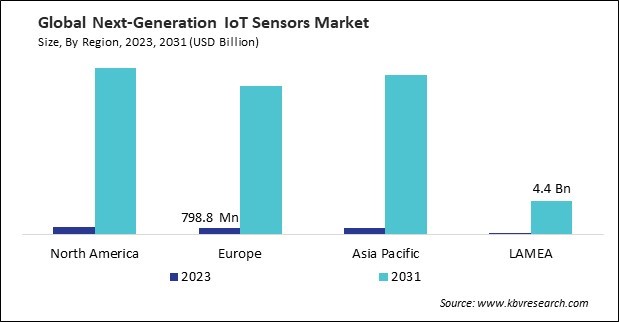Int'l : +1(646) 600-5072 | query@kbvresearch.com
Int'l : +1(646) 600-5072 | query@kbvresearch.com
Industry Insights | Market Trends | Highest number of Tables | 24/7 Analyst Support
According to a new report, published by KBV research, The Global Next-Generation IoT Sensors Market size is expected to reach $66.14 billion by 2031, rising at a market growth of 50.2% CAGR during the forecast period.
The Battery-Powered Sensors segment is leading the Global Next-Generation IoT Sensors Market by Power Source in 2023; thereby, achieving a market value of $39.9 billion by 2031. Battery-powered sensors are preferred due to their simplicity of installation and operation in remote or difficult-to-reach locations where access to power sources may be restricted. These sensors are commonly found in smart homes, industrial monitoring, and environmental sensing applications. Their ability to operate independently without a constant power supply makes them highly versatile and convenient for various use cases. However, the challenge of battery life and the need for periodic replacements can impact long-term deployment, particularly in large-scale installations.

The Bluetooth segment is anticipating a CAGR of 49.9% during (2024 - 2031). Bluetooth technology is commonly used in consumer electronics, healthcare devices, and wearable technologies due to its low power consumption, short-range capabilities, and ease of integration. Bluetooth Low Energy (BLE) has particularly gained popularity for IoT applications, enabling long battery life while maintaining efficient communication between devices. The rising trend of connected health devices and smart wearables has driven Bluetooth adoption in these markets.
The Temperature Sensors segment is generating maximum revenue in the Global Next-Generation IoT Sensors Market by Sensor Type in 2023; thereby, achieving a market value of $16.5 billion by 2031. Temperature sensors are essential for the monitoring of environmental conditions and the maintenance of optimal operational performance, as they are employed in a variety of applications, such as industrial automation, healthcare, smart homes, and agriculture. The increasing need for real-time data collection and analysis across various sectors, especially in climate-sensitive industries, drove the demand for these sensors.
The CMOS (Complementary Metal-Oxide-Semiconductor) segment is registering a CAGR of 49.8% during (2024 - 2031). The advantages of CMOS sensors, such as lower power consumption, cost-effectiveness, and ease of integration with other electronic devices, make them attractive for IoT applications requiring real-time image and video processing. The increasing use of AI-driven applications requiring visual data analysis has further spurred the demand for CMOS-based image sensors. Additionally, CMOS sensors are widely used in consumer electronics, where their high-performance capabilities and integration with other devices are key to enabling the development of smarter connected devices.
The Cloud-Based segment is exhibiting the highest revenue in the Global Next-Generation IoT Sensors Market by Deployment Type in 2023; thereby, achieving a market value of $34.8 billion by 2031. Cloud-based IoT sensor deployments involve storing and processing data on remote servers, which enables easy access, scalability, and integration with other cloud-based services. The flexibility, cost-effectiveness, and ease of maintenance offered by cloud solutions have made them highly attractive for businesses across various industries. Cloud-based IoT sensor deployments are particularly useful for applications that require global reach, such as smart cities, supply chain management, and large-scale industrial automation, where sensor data from multiple locations can be aggregated and analyzed centrally.
The Automotive segment would register a CAGR of 49.8% during (2024 - 2031). IoT sensors are integral to developing connected and autonomous vehicles, which enhance safety, navigation, and in-vehicle experience. Advanced driver-assistance systems (ADAS), which rely heavily on sensors such as radar, lidar, and cameras, are increasingly being integrated into vehicles to provide collision detection, lane-keeping assistance, and automated parking features. The automotive industry is positioned as a key participant in the market due to the increasing demand for electric vehicles (EVs) and the emergence of autonomous driving technologies. This has stimulated the adoption of IoT sensors.
Full Report: https://www.kbvresearch.com/next-generation-iot-sensors-market/
The North America region dominated the Global Next-Generation IoT Sensors Market by Region in 2023, and would continue to be a dominant market till 2031; thereby, achieving a market value of $21.6 billion by 2031. The Asia Pacific region is exhibiting a CAGR of 51.2% during (2024 - 2031). Additionally, The Europe region would experience a CAGR of 49.7% during (2024 - 2031).
By Power Source
By Connectivity
By Sensor Type
By Deployment Type
By Technology
By End-Use
By Geography
Related Reports: